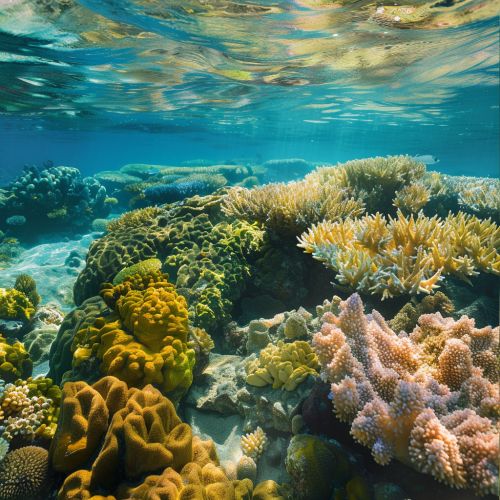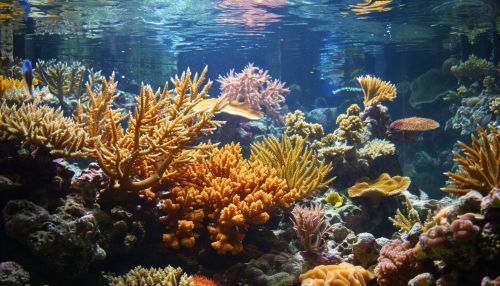Coral Diseases
Introduction
Coral diseases are a significant threat to coral reef ecosystems worldwide. These diseases can lead to extensive coral mortality, thereby affecting the biodiversity and structural complexity of coral reefs. Coral diseases are caused by a variety of pathogens, including bacteria, fungi, viruses, and protozoans. Environmental stressors such as elevated sea temperatures, pollution, and ocean acidification can exacerbate the prevalence and severity of these diseases.
Types of Coral Diseases
Coral diseases can be categorized based on their etiological agents and the symptoms they produce. Some of the most well-documented coral diseases include:
Black Band Disease (BBD)
Black Band Disease is characterized by a dark, necrotic band that moves across the coral colony, leaving behind dead, white skeleton. The band is composed of a complex microbial consortium, including cyanobacteria, sulfur-oxidizing bacteria, and sulfate-reducing bacteria. The primary cyanobacterium involved is Phormidium corallyticum.
White Band Disease (WBD)
White Band Disease primarily affects Acroporid corals and is identified by a white band of tissue loss that progresses from the base of the coral colony upwards. The exact causative agent is still under investigation, but it is believed to be bacterial in nature.
White Plague
White Plague is another bacterial disease that causes rapid tissue loss in corals. It is divided into three types: Type I, Type II, and Type III, with Type II being the most virulent. The bacterium Aurantimonas coralicida has been identified as a potential pathogen for White Plague Type II.
Yellow Band Disease (YBD)
Yellow Band Disease manifests as yellow or light brown bands or blotches on the coral tissue. It primarily affects the Montastraea species complex. The causative agents are believed to be a combination of bacteria and possibly other microorganisms.
Aspergillosis
Aspergillosis is a fungal disease caused by the fungus Aspergillus sydowii. It primarily affects sea fans (Gorgonia spp.) and is characterized by purple lesions and tissue necrosis.
Skeletal Eroding Band (SEB)
Skeletal Eroding Band is caused by the ciliate protozoan Halofolliculina corallasia. It appears as a dark band that erodes the coral skeleton, leaving behind a white, dead skeleton.


Pathogenesis and Transmission
The pathogenesis of coral diseases involves complex interactions between the host, pathogen, and environment. Pathogens can enter coral tissues through wounds, mucous membranes, or other points of entry. Once inside, they can disrupt cellular processes, leading to tissue necrosis and death.
Transmission of coral diseases can occur through direct contact, waterborne dispersal, or vector organisms such as fish and invertebrates. Environmental stressors, such as elevated sea temperatures and pollution, can weaken coral immune responses, making them more susceptible to infections.
Environmental Stressors
Environmental stressors play a crucial role in the prevalence and severity of coral diseases. Key stressors include:
Elevated Sea Temperatures
Elevated sea temperatures can lead to coral bleaching, a phenomenon where corals expel their symbiotic zooxanthellae, leading to a loss of color and vital energy sources. Bleached corals are more susceptible to diseases due to weakened immune responses.
Pollution
Pollution from agricultural runoff, sewage, and industrial activities can introduce harmful substances into marine environments. Nutrient pollution can lead to algal blooms, which can smother corals and create hypoxic conditions. Chemical pollutants can directly damage coral tissues and disrupt microbial communities.
Ocean Acidification
Ocean acidification, caused by increased atmospheric CO2 levels, reduces the availability of carbonate ions necessary for coral calcification. Acidified conditions can weaken coral skeletons and make them more susceptible to diseases.
Diagnostic Techniques
Accurate diagnosis of coral diseases is essential for effective management and conservation efforts. Diagnostic techniques include:
Visual Inspection
Visual inspection is the most straightforward method, involving the identification of characteristic disease signs such as tissue loss, discoloration, and band formation.
Histopathology
Histopathology involves the microscopic examination of coral tissues to identify cellular and subcellular changes associated with diseases. This technique can reveal the presence of pathogens and tissue damage.
Molecular Techniques
Molecular techniques, such as polymerase chain reaction (PCR) and DNA sequencing, are used to identify specific pathogens at the genetic level. These techniques can provide precise identification of bacterial, fungal, and viral agents.
Microbial Culturing
Microbial culturing involves growing pathogens in controlled laboratory conditions to identify and study them. This technique is useful for isolating and characterizing bacterial and fungal pathogens.
Management and Mitigation
Effective management and mitigation of coral diseases require a combination of strategies:
Monitoring and Surveillance
Regular monitoring and surveillance of coral reefs can help detect early signs of disease outbreaks. This involves underwater surveys, remote sensing, and the use of automated monitoring systems.
Environmental Management
Reducing environmental stressors is crucial for mitigating coral diseases. This includes implementing measures to control pollution, managing coastal development, and protecting water quality.
Restoration Efforts
Coral restoration efforts, such as coral gardening and transplantation, can help rehabilitate degraded reefs. These efforts involve the cultivation of healthy coral fragments and their transplantation to affected areas.
Research and Collaboration
Ongoing research is essential for understanding the complex interactions between corals, pathogens, and environmental factors. Collaboration between scientists, conservationists, and policymakers can facilitate the development of effective management strategies.
Conclusion
Coral diseases pose a significant threat to the health and sustainability of coral reef ecosystems. Understanding the types, causes, and transmission of these diseases is essential for developing effective management and mitigation strategies. By addressing environmental stressors and promoting research and collaboration, we can work towards preserving these vital marine ecosystems for future generations.
